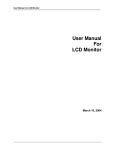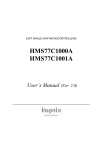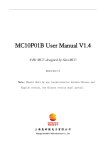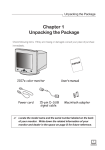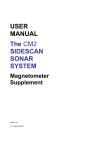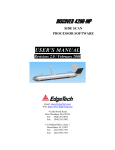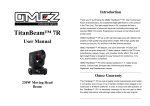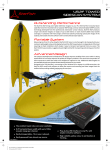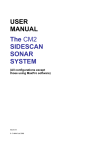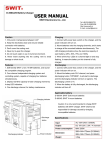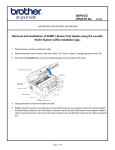Download USER MANUAL The CM2 SIDESCAN SONAR SYSTEM
Transcript
USER MANUAL The CM2 SIDESCAN SONAR SYSTEM AUV/ROV Supplement Version 1.2 © C-MAX Ltd 2011 Contents CONTENTS 1. Introduction ………… 1 2. System Components ………… 2 ………… 5 Sonar Transducers Towfish PCB AUV I/F PCB Sonar Transceiver (STR) 3. Installing the System Transducers Circuit Boards Interconnection Wiring Grounding Version 1.2 (2011) i Version 1.0 (2011) 1. Introduction 1. INTRODUCTION The CM2 Sidescan Sonar is normally configured as a towed system where the sonar head is referred to as a towfish. The key elements of the sonar head, namely the transducers and the Towfish PCB, are also suitable for mounting in an autonomous underwater vehicle (AUV). These items are also equally suitable for mounting on a remotely-operated vehicle (ROV) with the electronics protected by a pressure housing. An additional electronics board, the AUV Interface PCB (AUV I/F), handles all communication between the sonar head and the onboard computer or, alternatively in the case of an ROV, an umbilical multiplexer. The AUV I/F also generates clean power for the Towfish PCB. This supplement should be read in conjunction with the latest version of the CM2 User Manual. Version 1.2 (2011) 1 2. System Components 2. SYSTEM COMPONENTS Sonar Transducers Two faces of each sonar transducer are active. The main face transmits and receives at the two selected frequencies (325kHz and either 780kHz or 100kHz); the lower face transmits and receives at 325kHz primarily acting as an echo sounder to determine altitude but also ensuring that the ground directly below the vehicle is included in the acoustic coverage. The transducers are handed, left and right, for projection either side of the vehicle. The only difference between them is the end to which the cable is attached. Towfish PCB The Towfish PCB is similar to that fitted in the towfish body in systems designed for towed operation except that the heatsink, required by the mixing of data and power on a 2-wire tow cable, is not fitted . The Towfish PCB drives the sonar transducers and interfaces to an AUV I/F PCB through which it communicates with the acquisition PC. The Towfish PCB supplies the transducers with regular high voltage "ping" pulses, and then amplifies, filters and digitizes the echoes. The Towfish PCB also acts as a transceiver for the the link to the acquisition PC, via the AUV I/F PCB. The link transmits sonar data, status data and commands. AUV I/F PCB The AUV I/F, despite its name, can be applied to both ROV and AUV configurations. The AUV I/F PCB decodes the data from the sonar head, passing it via a USB link to the onboard computer or umbilical muliplexer. Commands are passed to the sonar head via the same link. As an alternative to USB an RS232 inferface is available if the zero-ohm link is removed from LK1 and fitted to LK2. The AUV I/F PCB generates clean 24VDC power for the Towfish PCB. Voltage isolation between the AUV I/F and Towfish PCB's is maintained for both power and data communication. This allows the electrical grounds of the sonar and the vehicle to be independent from each other. The PCB requires DC power in the range 10-28V at 3W. In standby mode the power requirement reduces to 0.5W. Sonar Transceiver (STR); certain ROV installations only As described in the main CM2 User Manual, the primary type of surface electronics unit for the towed CM2 system is the Sonar Transceiver, or STR. This unit provides power for the towfish via the tow cable, receives the echo data and other information such as the towfish altitude, and sends commands to the towfish. It needs only a 2-wire link for this communication, unlike the AUV I/F PCB which needs 4 conductors. An STR is included in an ROV configuration only when that configuration closely resembles the standard towed system; that is, when the sonar head (transducers and Towfish PCB) is linked to the surface directly by a single pair of dedicated conductors in the ROV umbilical. In this configuration an AUV I/F PCB is not required. STR's were also employed in early AUV installations but this role has been replaced by that of the AUV I/F PCB. Use of the STR is not discussed further in this supplement. Version 1.2 (2011) 2 2. System Components Transducers and Circuit Boards Version 1.2 (2011) 3 3. Installation 3. INSTALLATION Transducers Each transducer, in its backing plate, is 512mm long overall, with its cable extending a further 173mm to a wet-pluggable (Micro IL-5M) connector. The transducer cables can extend rearwards as in the towfish installation but the alternative configuration, with the transducers exchanged and both cables extending forward, is equally satisfactory. The transducers should be installed with their long sides horizontal and their main faces pointing approximately 10 degrees below the horizontal. The main face needs to be unobstructed for its full length; the lower face needs to be unobstructed only for the central 100mm of its length. However if the vehicle's design prevents the lower face having an unobstructed view, the system is supplied with an alternative version of the sonar head's firmware (programmed into the microcontroller on the Towfish PCB). In ROV installations the transducers are often mounted some distance apart, on opposite sides of the vehicle. Transducer extension cables are available to accommodate this. Custom shapes of transducer and backing plate are available to special order. The detail drawing of the backing plate is also available to assist any customer who wishes to manufacture a modified version. Circuit Boards The Towfish PCB should be mounted as close to the sonar transducers as practicable, avoiding any location close to sources of electrical noise. The Towfish PCB uses 2.7mm laminate, compared with the more usual 1.6mm, but it has a long span between mounting points and may need to be supported centrally to meet vehicle shock specifications. If so it should be gripped at its edges using material that will not damage the laminate. The location of the AUV I/F PCB is less critical than that of the Towfish PCB but it is again good practice to minimize the possibility of noise coupling into the PCB and its cabling. Version 1.2 (2011) 4 3. Installation Mounting dimensions (all to scale) Version 1.2 (2011) 5 3. Installation Interconnection Wiring The wiring between the various elements is as follows:Cable A: J1, Towfish PCB - LH transducer via bulkhead connector Cable B: J2, Towfish PCB - RH transducer via bulkhead connector Cable C: J5, Towfish PCB - J2, AUV I/F (power to Towfish PCB) Cable D: J6, Towfish PCB - J3, AUV I/F (data and commands) Cable E: J1, AUV I/F PCB - Vehicle power rail Cable F: J4, AUV I/F PCB - Vehicle computer or multiplexer These cables are wired as follows:Cable A: 5-way 3.81mm pitch connector (J1) to Micro BH-5F-S/S bulkhead socket Cable B: 5-way 3.81mm pitch connector (J2) to Micro BH-5F-S/S bulkhead socket Cable C: 2-way 0.1" pitch connector (J5) to 2-way XH250 connector (J2) Cable D: 3-way 0.1" pitch connector (J6) to 3-way XH250 connector (J3) Cable E: 2-way XH250 connector (J1/1 = GND; J1/2 = 10-28VDC) Cable F: 5-way XH250 connector (J4/3 = GND; J4/4 = USBDATA+; J4/5 = USBDATA-; if LK1 is fitted) or Cable F: 5-way XH250 connector (J4/1 = RS232 Rx; J4/2 = RS232 Tx; J4/3 = GND; if LK2 is fitted) All cables are supplied by C-MAX, though their length may need to be adjusted by the installer. Cables A through D are wired one-for-one, that is pin 1 on one end connects to pin 1 on the other, and so on. Assembly of Cables A and B can only be completed after the bulkhead connectors have been screwed into position. These two cables should each be a tightly twisted bundle to minimize the sensitivity to electrical noise. For ROV installations where the Towfish PCB is housed in a Sonar Bottle, Cable C and Cable D must pass through additional bulkhead connectors, usually a 6-way connnector Micro BH-6M-S/S on the bottle and a Micro BH-6F-S/S on the ROV body. Grounding The isolated pad that includes the single M4 hole in the Towfish PCB, located centrally at one end, should be electrically connected to the vehicle's body or seawater ground. This seawater ground is capacitively coupled to 0V on the Towfish PCB. Note that power to the Towfish PCB is provided by an isolated supply so its local 0V is independent of the AUV I/F PCB ground. The AUV I/F ground must be directly connected to the vehicle's logic ground. © C-MAX Ltd 2011 Version 1.2 (2011) 6 (This page intentionally blank) Version 1.0 (2010) 7











